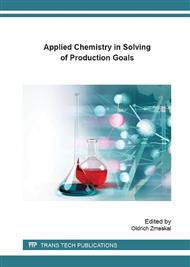[1]
M. Collepardi, The new concrete, S. l.: Grafiche Tintoretto, 2006, ISBN 88-901-4694-X.
Google Scholar
[2]
B. Lothenbach, K. Scrivener, R.D. Hooton, Supplementary cementitious materials, Cem. Concr. Res. 41 (2011) 1244-1256.
DOI: 10.1016/j.cemconres.2010.12.001
Google Scholar
[3]
C. Shi, P.V. Krivenko, D. Roy, Alkali-activated cements and concretes, Taylor & Francis, London, 2006, ISBN 04-157-0004-3.
DOI: 10.4324/9780203390672
Google Scholar
[4]
M.B. Mohd Salahuddin, M. Norkhaurunnisa, F. Mustapha, A review on thermophysical evaluation of alkali-activated geopolymers, Ceram. Int. 41 (2015) 4273-4281.
DOI: 10.1016/j.ceramint.2014.11.119
Google Scholar
[5]
F. Purtas, M. Palacios, H. Manzano, J.S. Dolado, A. Rico, J. Rodríguez, A model for the C-A-S-H gel formed in alkali-activated slag cements, J. Eur. Ceram. Soc. 31 (2011) 2043–(2056).
DOI: 10.1016/j.jeurceramsoc.2011.04.036
Google Scholar
[6]
A.R. Brough, A. Atkinson, Sodium silicate-based, alkali-activated slag mortars. Part I. Strength, hydration and microstructure, Cem. Concr. Res. 32 (2002) 865-879.
DOI: 10.1016/s0008-8846(02)00717-2
Google Scholar
[7]
M. Palacios, F. Puertas, Effect of shrinkage-reducing admixtures on the properties of alkali-activated slag mortars and pastes, Cem. Concr. Res. 37 (2007) 691-702.
DOI: 10.1016/j.cemconres.2006.11.021
Google Scholar
[8]
F. Collins, J.G. Sanjayan, Effect of pore size distribution on drying shrinking of alkali-activated slag concrete, Cem. Concr. Res. 30 (200) 1401-1406.
DOI: 10.1016/s0008-8846(00)00327-6
Google Scholar
[9]
J. Koornneef, M. Junginger, A. Faaij, Development of fluidized bed combustion—An overview of trends, performance and cost, Prog. Energy. Combust. Sci. 33 (2007) 19-55.
DOI: 10.1016/j.pecs.2006.07.001
Google Scholar
[10]
G. Sheng, J. Zhai, Q. Li, F. Li, Utilization of fly ash coming from a CFBC boiler co-firing coal and petroleum coke in Portland cement, Fuel, 86 (2007) 2625-2631.
DOI: 10.1016/j.fuel.2007.02.018
Google Scholar
[11]
G. Sheng, Q. Li, J. Zhai, Investigation on the hydration of CFBC fly ash, Fuel, 98 (2012) 61-66.
DOI: 10.1016/j.fuel.2012.02.008
Google Scholar
[12]
M. Maslehuddin, O.S.B. Al-Amoudi, M. Shameem, M.K. Rehman, M. Ibrahim, Usage of cement-kiln dust in cement products – Research review and preliminary investigations, Constr. Build. Mater. 22 (2008) 2369-2375.
DOI: 10.1016/j.conbuildmat.2007.09.005
Google Scholar
[13]
M.M. Shoaib, M.M. Balaha, A.G. Abdel-Rahman, Influence of cement kiln dust substitution on the mechanical properties of concrete, Cem. Concr. Res. 30 (2000) 371-377.
DOI: 10.1016/s0008-8846(99)00262-8
Google Scholar
[14]
R. Siddique, Utilization of cement kiln dust (CKD) in cement mortar and concrete—an overview, Resour. Conserv. Recycl. 48 (2006) 315-338.
DOI: 10.1016/j.resconrec.2006.03.010
Google Scholar
[15]
Kunal, R. Siddique, A. Rajor, Use of cement kiln dust in cement concrete and its leachate characteristics, Resour. Conserv. Recycl. 61 (2012) 59-68.
DOI: 10.1016/j.resconrec.2012.01.006
Google Scholar
[16]
P. Chaunsali, S. Peethamparan, Novel Cementitious Binder Incorporating Cement Kiln Dust: Strength and Durability, ACI Mater J. 110 (2013) 297-304.
DOI: 10.14359/51685663
Google Scholar
[17]
A. Buchwald, M. Schulz, Alkali activated binders by use of industrial by-products, Cem. Concr. Res. 35 (2005) 968-973.
DOI: 10.1016/j.cemconres.2004.06.019
Google Scholar
[18]
M.S. Konsta-Gdoutos, S.P. Shah, Hydration and properties of novel blended cements based on cement kiln dust and blast furnace slag, Cem. Concr. Res. 33 (2003) 1269-1276.
DOI: 10.1016/s0008-8846(03)00061-9
Google Scholar
[19]
V. Bílek, L. Kalina, E. Bartoníčková, T. Opravil, Influence of Industrial By-Products on Shrinkage of Alkali-Activated Slag, Adv. Mater. Res. 1000 (2014) 137-140.
DOI: 10.4028/www.scientific.net/amr.1000.137
Google Scholar
[20]
S. Diamond, Mercury porosimetry: An inappropriate method for the measurement of pore size distributions in cement-based materials, Cem. Concr. Res. 30 (2000) 1517-1525.
Google Scholar


